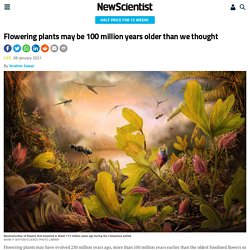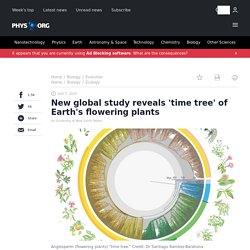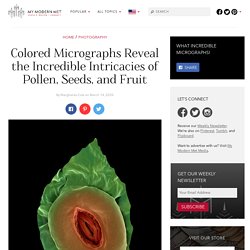

Flowering plants may be 100 million years older than we thought. By Ibrahim Sawal Flowering plants may have evolved 250 million years ago, more than 100 million years earlier than the oldest fossilised flowers so far found.

Today, flowering plants – known as angiosperms – are the most diverse group of land plants. The oldest angiosperm fossils so far found are 135 million years old, and many researchers believe this is when the group originated. The fossil record suggests the group then became diverse by 130 million years ago. But how flowering plants became highly diverse so shortly after their emergence has long perplexed researchers, including Charles Darwin. Advertisement To take another look, Daniele Silvestro at the University of Fribourg, Switzerland, and his team analysed more than 15,000 fossils from around 200 different angiosperm families to create a more accurate timeline. “We wanted to have a model that only relies on fossils and doesn’t use genomic data or [evolutionary] assumptions,” says Silvestro.
Tree ferns are older than dinosaurs. And that's not even the most interesting thing about them. With massive fronds creating a luxuriously green canopy in the understory of Australian forests, tree ferns are a familiar sight on many long drives or bushwalks.

But how much do you really know about them? First of all, tree ferns are ferns, but they are not really trees. To be a tree, a plant must be woody (undergo secondary plant growth, which thickens stems and roots) and grow to a height of at least three metres when mature. While tree ferns can have single, thick trunk-like stems and can grow to a height of more than 15 metres, they are never woody. Researchers Use 32,000-Year-Old Seeds to Grow and Examine Plants. Thanks to the work of squirrels, researchers in Siberia were able to grow viable Silene stenophylla plants from 32,000-year-old seeds.

This incredible event, which happened in 2012, is still having a dramatic event on the scientific community and now Austrian researchers are trying to sequence the plant's DNA to find out how it was able to survive so long. The story starts over 10 years ago, when a team of Russian, Hungarian, and American scientists recovered the frozen seeds in 2007. They were buried 125 feet underground, deep in the Siberian permafrost. The team was investigating the burrows of ancient squirrels when they made the discovery. New global study reveals 'time tree' of Earth's flowering plants. New research published today in Nature Ecology & Evolution by scientists from Australia and Mexico reveals the world's first complete angiosperm "time tree"—a reconstruction of the evolution of the Earth's flowering plants through time.

The rise of angiosperms (flowering plants) began about 140 million years ago, sparking one of the most dramatic biological revolutions of our planet's recent history. Crucial questions around the timing and location of the origin of the families involved in creating the most diverse type of plants on Earth were until now, largely unanswered. Tree ferns are older than dinosaurs. And that's not even the most interesting thing about them.
These Colored Micrographs Show the Incredible Intricacies of Plants. Fagus grandifolia – American beech; highly magnified view of a stoma on the leaf surface.

Hand-colored micrograph. Artist Rob Kesseler merges the disciplines of art and science in his Canopy series, which explores the up-close intricacies of plant life that are normally unseeable. To capture these incredible magnified pictures, Kesseler employs scanning electron microscopy (SEM), which he then meticulously colors by hand. These micrographs show the wondrous details of pollen, seeds, and fruit. Despite his penchant for micrography, Kessler is actually a professor at Central Saint Martins and Chair of Arts, Design & Science at University of the Arts London.
15 Stunning Photos That Prove You Have No Clue How Food Is Grown. We all enjoy eating delicious foods but most of us have absolutely no idea how that food grows or is produced.

Plants Emit Sounds Too High For Human Ears When Stressed Out. Cyborg plants could be the future of electronics. Humans have driven nearly 600 plant species to extinction since 1750s. Piękne ujęcie w kadrze. Co trzy głowy to... - Zamość i Roztocze (Zamojszczyzna) When Fungi Fight Back. Nature's art.. - Green Renaissance. Back to Nature - Tulip forest □ Plants communicate distress using their own kind of nervous system. Plants may lack brains, but they have a nervous system, of sorts.

And now, plant biologists have discovered that when a leaf gets eaten, it warns other leaves by using some of the same signals as animals. The new work is starting to unravel a long-standing mystery about how different parts of a plant communicate with one another. Animal nerve cells talk to each other with the aid of an amino acid called glutamate, which—after being released by an excited nerve cell—helps set off a wave of calcium ions in adjacent cells. The wave travels down the next nerve cell, which relays a signal to the next one in line, enabling long-distance communication.
What Plants Talk About (Full Documentary) This plant was bullied for a month - Be Inspired. Aspire. Blazes of light reveal how plants signal danger long distances. In one video, you can see a hungry caterpillar, first working around a leaf's edges, approaching the base of the leaf and, with one last bite, severing it from the rest of the plant.

Within seconds, a blaze of fluorescent light washes over the other leaves, a signal that they should prepare for future attacks by the caterpillar or its kin. That fluorescent light tracks calcium as it zips across the plant's tissues, providing an electrical and chemical signal of a threat. This Stunning Animation Beautifully Illustrates the Secret Life of Flowers.
Learning to Speak Shrub - Issue 59: Connections. Entomologist Richard Karban knows how to get sagebrush talking.

To start the conversation, he poses as a grasshopper or a chewing beetle—he uses scissors to cut leaves on one of the shrubs. Lopping off the leaves entirely won’t fool the plants. So he makes many snips around the edges and tips of the leaves—“a lot of little bites.” A few months later, Karban, a professor at the University of California, Davis who studies plant defense communication, returns to the sagebrush and examines its leaves, many of which now have damage from real grasshoppers or beetles. Microscopic Images Of Seeds. The diversity and intricacy of shapes and sizes of seeds is extraordinary.

Even more amazing is that within even the tiniest of seeds lies the complete genetic information required to birth and structure such organisms as the complex passion flower, or a 360 foot tall sequoia. Seeds are also amazing travelers, either with the help of the wind or by hitching rides with neighboring wildlife. If stored in ideal conditions, seeds can also spring to life, after hundreds of years of lying dormant. More often than not, the smaller the seed, the more texture found on its surface. Image by Rob Kesseler, robkesseler.co.uk. Research Reveals Plants Can Think, Choose & Remember. Land plants arose earlier than thought—and may have had a bigger impact on the evolution of animals. We have land plants to thank for the oxygen we breathe. And now we have a better idea of when they took to land in the first place. While the oldest known fossils of land plants are 420 million years old, researchers have now determined that pond scum first made landfall almost 100 million years earlier.
How Plants Defend Themselves - Nature and Community. Broccoli no more aspires to sizzling in a stir-fry than pigs dream of becoming ham.Illustration By Brad Anderson Seedlings of parasitic dodder plants scout for volatile chemicals released by a potential host, such as the tomato, then put out tendrils to slowly encircle their victim and suck out its life.Illustration By Brad Anderson Some plants "call" for backup whenever they're attacked.Illustration By Brad Anderson The more researchers study the science of plants, the more remarkable those chlorophyll-filled wonders seem to be. Plant Identification. 12 Photos That Prove We Have No Idea How Food Grows. A young father once asked his little girl where coffee comes from. His little girl responded, “from the can of course!” When you stop to think about it, there are a lot of different foods with unique origins that we take for granted almost every day. Plants. Plant Architecture and Its Evolutionary Implications — In Defense of Plants.
Another interesting finding borne from these models is that there doesn't seem to be strong correlations between architecture and phylogeny. Although species within a specific genus often share similar architecture, there are plenty of exceptions. What's more, the same form can occur in unrelated species. For instance, Aubréville's model occurs in at least 19 different families. Similarly, the family Icacinaceae, which contains somewhere between 300 and 400 species, exhibits at least 7 of the different models. Alternatively, some families are architecturally quite simple. So, at this point the question of what is governing these models becomes apparent. Although many scientists have attempted to tackle these sorts of questions, I want to highlight the work of one individual in particular - Dr. 1) Plants have to capture sunlight and avoid shading their own leaves.
The best apps to identify unknown plants and flowers. PlantSnap. Pl@ntNet. Leafsnap: An Electronic Field Guide. Plantifier on the App Store. Massive Database of 182,000 Leaves Is Helping Predict Plant Family Trees. The story of a plant is etched in its leaves. A tree growing in a cold environment with plenty of water is more likely to have large leaves with many serrated teeth around the edges. But if the same species lives in a warm, dry region, its leaves are likely to be smaller and smoother. Untitled. Svt. – Jo, faktiskt. Och det är ju för att näckrosen är en väldigt gammal blomväxt. Den är en systergrupp till ”urmodern” tror man, säger Vivi Vajda, professor i paleontologi och geolog vid Naturhistoriska riksmuseet.
AMKK(東 信、花樹研究所) Scientists Discover Plants Have "Brains" That Determine When They Grow. Plants have a long and unexpected evolutionary lineage. Land plants evolved 450 million years ago, but sharks are older than trees; flowers didn’t appear until the Cretaceous Period, and grass only starting sprouting 40 million years ago. Kenny Ausubel: Imagining Our Way Out of the Unimaginable. This Incredible Flower Timelapse Took 3 Years and 8TB of Photos to Create. Filmmaker Jamie Scott made his name in the timelapse space with Fall, a Central Park timelapse of epic proportions that took 6 months of dedication to capture. And yet his followup timelapse, titled Spring, somehow puts his first creation to shame. Spring is the flower timelapse to end all flower timelapses. “All in all this took 3 years to shoot,” writes Jamie on Vimeo. Svt. I ett laboratorium i källaren på Sveriges Lantbruksuniversitet sitter fyra uppkopplade bladlöss på varsitt blad.
Remarkable Photos Capture the Light That Plants Emit. SEED: The Untold Story. Ancient plants reawaken: Plants exposed by retreating glaciers regrowing after centuries entombed under ice. When University of Alberta researcher Catherine La Farge threads her way through the recently exposed terrain left behind by retreating glaciers, she looks at the ancient plant remains a lot closer than most. Plants 'do maths' to control overnight food supplies. Plants perform molecular maths.
Portals. Flora. Plant Mind. World Flora Online. The New York Botanical Garden (NYBG) is one of four prominent international botanical organizations leading the effort to forge the WFO, along with the Missouri Botanical Garden, the Royal Botanic Gardens-Kew, and the Royal Botanic Gardens-Edinburgh.
An additional 30 research institutions from many of the world's most biologically diverse countries, including Brazil, China, Colombia, India, Malaysia, Mexico, Russia, and Thailand, have also committed to contributing content as primary partners. FloraGator - a multiple-entry key for flowering plant family identification. How plants decide that it is time to flower.
Visionary plants - AoBBlog. Earth - How insect-eating plants persuade insects to pollinate them. Archaeologists Dig Up An 800-Year-Old Pot. What They Found Inside Is Changing History! 10 Plants That Could Kill You. Maps. Vegetation as Seen by Suomi NPP. Flowers get an electrifying buzz out of visiting bees. Earth - Plants talk to each other using an internet of fungus. The Mystery Of Why Sunflowers Turn To Follow The Sun — Solved. This Is How Our Favourite Foods Look In Their Natural Habitats (Photos) Weird Flowers That Become Transparent When It Rains. The smell of freshly-cut grass is actually a plant distress call. Plants Know They Are Being Eaten. Plants Exhibit The Same Senses As Humans And See, Touch, Smell, Hear and Even Taste. Meet The World's Largest Living Organism. Fantastic Fungi: The Forbidden Fruit. Earth's Internet & Natural Networking: Mycorrhizal Fungi run the Largest Mining Operation in the World.
16 Of The Most Magnificent Trees In The World. Plants Communicate Using An Internet Of Fungus. Ferns "Talk" Via Pheromones To Decide Sex. In The Mind Of Plants - Documentary. What Plants Talk About ~ Full Episode. How Plants Help Each Other Grow By Near-Telepathic Communication.